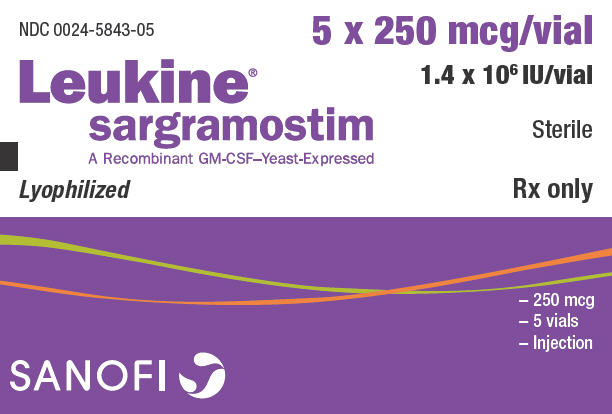Can Sargramostim Help Alleviate Radiotherapy Side Effects?

Can Sargramostim Help Alleviate Radiotherapy Side Effects?
For cancer patients undergoing radiotherapy, the treatment is often a double-edged sword. While it offers hope in fighting the disease, it also brings along a series of side effects that can significantly impact the quality of life. Amid these challenges, many patients wonder if there's a way to ease the burden. Sargramostim, a medication with specific therapeutic properties, has emerged as a topic of interest. In this article, we'll explore whether Sargramostim can help alleviate the side effects of radiotherapy, providing valuable insights for those in need. If you have further questions, you can consult the Dingxiang customer service.
Common Side Effects of Radiotherapy
Radiotherapy is a widely used and effective cancer treatment method. However, it doesn't come without its drawbacks. Patients frequently encounter a range of side effects during and after radiotherapy. These include nausea, vomiting, loss of appetite, fatigue, and skin irritation. The radiation's impact on the bone marrow is particularly concerning, as it often leads to a decrease in white blood cell count, a condition known as leukopenia. This reduction in white blood cells weakens the immune system, making patients more susceptible to infections. Such infections can disrupt the continuity of radiotherapy and potentially affect the overall treatment outcome.
The Mechanism of Action of Sargramostim
Sargramostim, also known as recombinant human granulocyte-macrophage colony-stimulating factor, plays a crucial role in the body's hematopoietic process. Its primary function is to stimulate hematopoietic stem cells in the bone marrow, promoting the production and maturation of white blood cells, especially the proliferation of granulocytes. When a patient experiences leukopenia due to radiotherapy or other causes, Sargramostim can step in to boost the immune function. By increasing the number of white blood cells, it helps reduce the risk of infections. Additionally, as the immune system recovers, patients may notice an improvement in their overall well - being and quality of life.
Research Progress of Sargramostim in Radiotherapy
Several clinical studies have investigated the application of Sargramostim in radiotherapy. The results show promising potential. Research indicates that Sargramostim can effectively reduce leukopenia in patients receiving radiotherapy, thereby decreasing the incidence of infections. In particular, patients treated with Sargramostim during radiotherapy tend to experience a significantly faster recovery of neutrophils, a type of white blood cell. This accelerated recovery enhances patients' tolerance to radiotherapy, allowing them to better endure the treatment process and potentially improving the treatment's effectiveness, especially for patients with acute myeloid leukemia.
Considerations on Price and Clinical Application
While Sargramostim shows potential in alleviating radiotherapy side effects, its price is a factor that cannot be ignored. The cost of Sargramostim treatment can vary, and for some patients, it may pose an economic burden. Moreover, like any medication, Sargramostim has its own set of adverse reactions. Common side effects include fever, rash, diarrhea, vomiting, mucosal diseases, hair loss, fatigue, loss of appetite, gastrointestinal problems, and edema. Rare but more serious side effects can involve allergic reactions, bronchospasm, heart failure, supraventricular arrhythmia, cerebrovascular diseases, confusion, convulsions, breathing difficulties, pulmonary edema, and fainting. It can also cause severe hematological adverse reactions such as agranulocytosis and thrombocytopenia.
When considering the use of Sargramostim in radiotherapy, doctors need to comprehensively evaluate each patient's individual condition, including their overall health, the type and stage of cancer, and the potential benefits and risks. Determining the optimal indications and timing of Sargramostim use requires further research. In the process of formulating personalized treatment plans, the cost - effectiveness of the drug and its side effects must be carefully weighed.
In the future, with more in - depth research and clinical trials, Sargramostim may become an important supplement in the healthcare of cancer patients during radiotherapy. However, at present, while it shows the potential to relieve radiotherapy side effects, especially for acute myeloid leukemia patients, more evidence is needed to determine its best application in radiotherapy.
Q&A Cases
Q: I'm a cancer patient about to start radiotherapy. My doctor mentioned Sargramostim, but I'm worried about its side effects. How common are the severe side effects?
A: While Sargramostim can have a range of side effects, severe ones such as allergic reactions, heart failure, or severe hematological problems are relatively rare. However, everyone's body reacts differently. Your doctor will consider your overall health condition before prescribing it. If you have any pre - existing conditions or concerns, make sure to discuss them thoroughly with your doctor. You can also reach out to the Dingxiang customer service for more information about managing potential side effects.
Q: Is Sargramostim very expensive? I'm on a tight budget, and I'm not sure if I can afford it.
A: The price of Sargramostim can vary depending on factors such as the dosage, treatment duration, and where you obtain the medication. It's true that for some patients, it may be a financial challenge. You can talk to your doctor about possible alternatives or discuss with the hospital's financial counselor to see if there are any assistance programs available. Additionally, consulting the Dingxiang customer service might also provide you with more information on cost - effective options.
